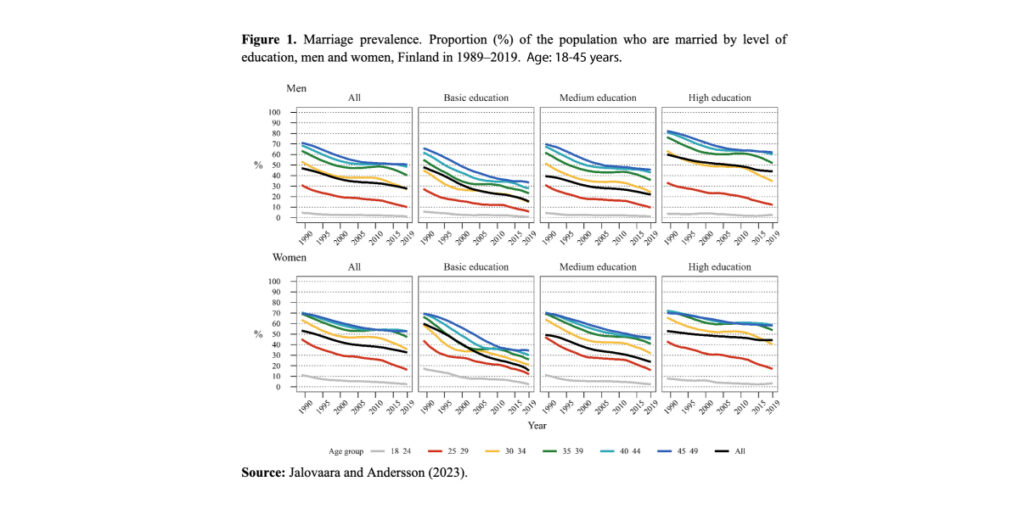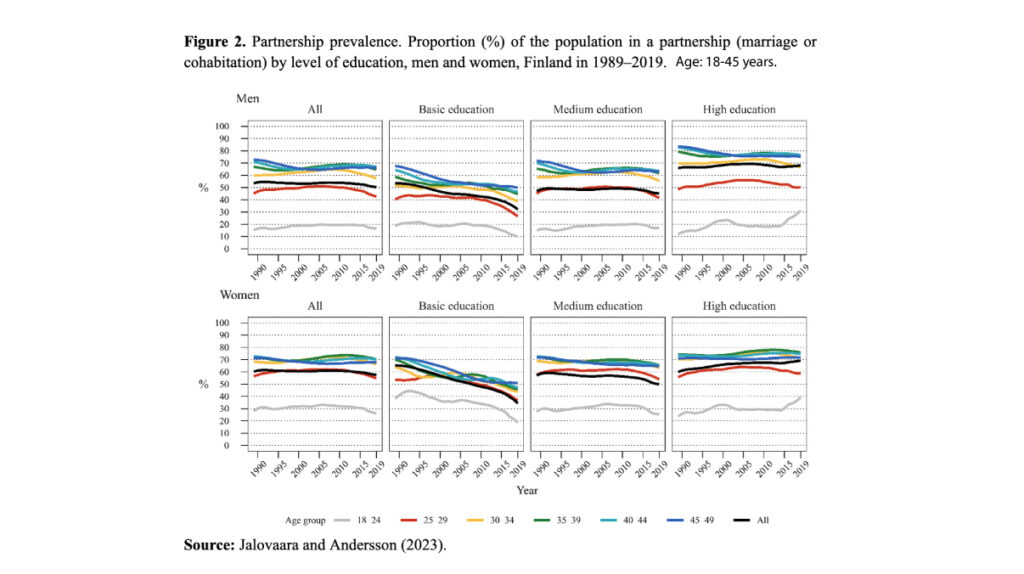As marriage declines and divorce increases, partnership trends and household composition become increasingly determined by trends in the formation and dissolution of non-marital cohabiting unions. Marika Jalovaara and Linus Andersson show that in Finland, the decline in marriage is not offset by an equivalent increase in cohabitation, and educational disparities in the prevalence of unions have increased somewhat from already-high levels in 1990. These patterns are remarkably similar for men and women.
The decline in marriage and the increase in divorce have continued well beyond the turn of the millennium in the Nordic countries and elsewhere. But does that mean that fewer people live with a partner? And are trends similar across gender and educational levels? To evaluate the trends in partnerships and the educational gradients therein, in a recent paper we analysed both marital and non-marital forms of (coresidential) partnership formation and dissolution from 1990 to 2019 in Finland (Jalovaara and Andersson 2023).
Trends in cohabitation and marriage
One of the major changes in family behaviour of the 20th century was that fewer people married and among those who did, more divorced. Family demographers have long pointed out that trends in marriage and divorce rates are consequential for both childbearing and well-being. Yet, non-marital partnerships have to some extent replaced marital ones, maintaining a balance in the share of the population living with a partner. However, this “compensating” effect may be only partial, in part because of sheer numbers, and in part because, while all forms of partnership are critical for individuals’ childbearing and household economy, marriage remains a stronger predictor of fertility and (relational and financial) stability than simple cohabitation.
The picture is further complicated by disparate evidence suggesting that trends in marital and non-marital partnerships differ for men and women, even when they have comparable educational levels. Finally, quality data on non-marital partnership formation and dissolution over time are generally scant.
This is not the case in Finland, however, where we could access population register data that include the dates of marriage and divorce as well as the dates of non-marital cohabitation and dissolution for the entire population from 1990 to 2019. We focused on the age groups from 18 to 45 years because these are the ages when partnership formation is most common (and relevant for childbearing). We found that marriage prevalence (the share of the population who are married) declined in Finland across all educational groups among both men and women (Figure 1). In total, the share of married persons declined from 48% to 28% for all men from 53% to 33% for all women, with levels that are lower, the younger the age group.

We then considered partnership prevalence as a status of being either married or in a non-marital cohabiting union (Figure 2). If non-marital partnerships have indeed replaced marital partnerships, we would expect stability in total partnership prevalence from 1990 to 2019. Instead, we found a decline in total union prevalence. This is particularly the case among the group without upper secondary education, among whom the prevalence has fallen by more than 20 percentage points for men and almost 30 percentage points for women. Among individuals with medium levels of education, total union prevalence has decreased by three to eight percentage points over the past three decades. In contrast, we found a slight increase in total partnership prevalence among men and women with high education, although not for all age groups.

Further analyses of the formation and dissolution of non-marital unions led us to conclude that non-marital unions were not sufficiently numerous and durable to fully compensate for the decline in marriage. Rates of separation (the share of partnered individuals who separate) have increased steadily over time across all types of union, while total partnering rates (the share of those who marry or enter a cohabiting union among the population not married or cohabiting) have been declining since around 2010 (Table 1).

Implications
The decline in marriage and the increase in divorce are key features in the changing picture of the demography of the family. Yet, this is only half of the story: non-marital cohabitation has replaced marital unions but only to a limited extent. Forming a partnership and having children are fundamentally related. A higher share of non-marital cohabiting unions – more prone to partnership break-up than marriages – in combination with a lower total partnering rate during childbearing ages, can have negative consequences for childbearing.
A reversed, or different, causal chain is also possible. The partnership trends we observe in Finland may be driven by a decreased desire for childbearing, or there may be common underlying forces that depress childbearing and partnerships. Be as it may, a trend away from partnerships is, in itself, likely to depress fertility.
Moreover, trends toward fewer and less stable couple households have implications for welfare policies. The household is a core economic unit and often protects against financial risks (e.g. unemployment). In countries where redistributive policy is adapted to dual-earner households in particular, trends towards fewer partnerships should be taken into consideration.
Finally, these trends are largely uniform across gender, even at comparable levels of education. While substantial differences exist, these are matters of degree rather than kind. Other studies (Kolk 2022, Andersson 2022) also show that educational and socioeconomic differences in family dynamics are similar in gender-egalitarian Nordic countries such as Finland, where women and men now have quite similar social and economic roles.
References
Andersson, Linus. ‘The Contribution of Partnership Contexts of Births to Cohort Fertility Rates’. SocArXiv, 3 January 2023. .
Jalovaara Marika, Andersson Linus (2023). A register-based account of period trends in union prevalence, entries, and exits by educational level for men and women in Finland. Demographic Research, 48 [14], 373–386. 10.4054/DemRes.2023.48.14
Kolk, M. (2022). The relationship between life-course accumulated income and childbearing of Swedish men and women born 1940–70. Population Studies, 1-19. https://doi.org/10.1080/00324728.2022.2134578


